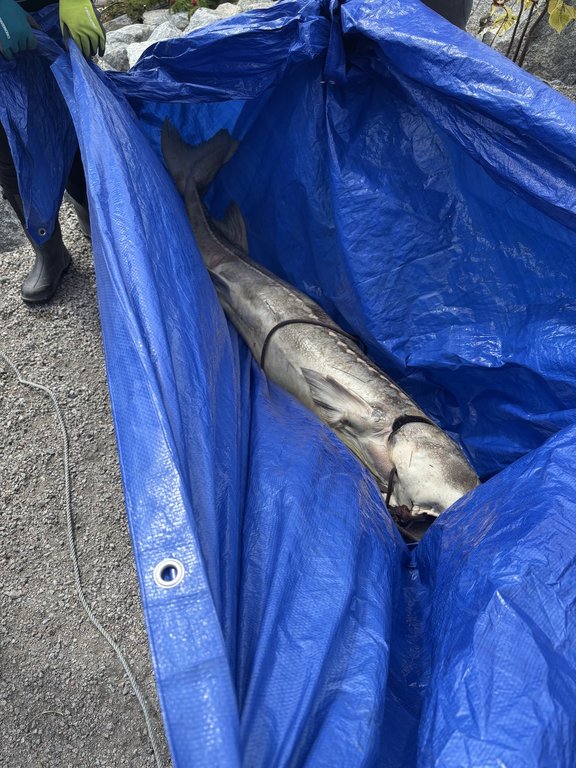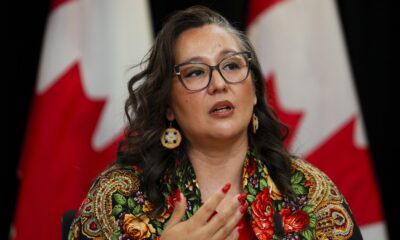Science
Tsawwassen First Nation Investigates Rising Sturgeon Deaths

The Tsawwassen First Nation is actively investigating a concerning increase in sturgeon deaths along the Fraser River in British Columbia. Earlier this month, four individuals worked together to remove a sturgeon carcass measuring approximately 1.6 metres from the riverbanks in Richmond, one of many that have washed ashore recently. The fish will be preserved for research purposes, ultimately fitted with an electronic tracker to monitor its movements as part of a broader conservation effort.
Biologist Kelly Scott, who is leading the research for the First Nation, expressed alarm over the mortality events. Sturgeons, which have existed for around 200 million years, are being reported dead in increasing numbers, raising questions about environmental changes affecting their survival. “We have received multiple reports this year from residents in New Westminster who have witnessed several sturgeon floating down the river within a single day,” Scott stated, highlighting the urgency of the situation.
According to British Columbia’s Ministry of Land, Water and Resource Stewardship, there has been a notable uptick in sturgeon mortalities this year, with reports of 71 dead sturgeon across the province since July. Of these, 65 were found in the lower Fraser River, with 49 reported in the last four weeks alone. For comparison, the ministry noted there were only 42 reported mortalities in the lower Fraser throughout all of 2024.
Understanding the Causes of Mortality
The white sturgeon, one of the largest and longest-living fish, can reach lengths of up to six metres and live for more than 100 years. This species holds significant cultural and nutritional value for First Nations, including the Tsawwassen, who have historically harvested sturgeons. In 1994, British Columbia prohibited the harvest of sturgeon, and First Nations voluntarily ceased harvesting at the same time. Despite this, catch-and-release angling remains permitted in the lower Fraser River.
Scott indicated that multiple factors could contribute to the observed mortality rates, with climate change being a primary concern. Warmer water temperatures can stress the fish, as the river lacks sufficient shaded areas for thermal refuge. “When sturgeons are already stressed, their chances of survival decrease if they are caught in gill nets targeting other species,” she explained.
The research team is focusing on identifying cooler habitats for sturgeon and planning restoration efforts in those areas. Additionally, threats from large vessels, which can cause fatal injuries, were highlighted, as evidenced by one sturgeon found with a significant gash on its back.
Research Initiatives and Future Plans
The Tsawwassen research team is responding to reports of dead sturgeon and documenting any injuries. Their goal is to collect 20 carcasses, although many found have been too decomposed for use. The plan involves drifting carcasses fitted with telemetry trackers downstream to better understand their movement patterns under various environmental conditions.
The project aims to clarify the reasons behind sturgeon mortality and determine whether reported deaths accurately reflect actual mortality rates. Collaborations with researchers from the University of B.C. are also underway to explore environmental genomics, utilizing DNA and RNA samples from the aquatic environment to gain insights into sturgeon habitats and stress levels.
The provincial government suspects that a combination of factors, including disease and warmer waters, may be contributing to sturgeon deaths. A statement from Fisheries and Oceans Canada noted that water temperatures in the Fraser River exceeded 20°C during the summer, increasing the risk of stress and mortality for sturgeon, which typically struggle at temperatures above 18°C.
While the flurry of fishing activity this year could correlate with the increase in sturgeon deaths, the ministry clarified that there is no direct evidence linking the recent salmon fishery to these mortalities. They emphasized the importance of investigating all potential contributing factors to fully understand the situation.
Sturgeon populations are protected under federal species-at-risk legislation in various regions of British Columbia. The upper Fraser, upper Columbia, upper Kootenay, and Nechako River populations have been classified as endangered since 2006, while the lower Fraser population is considered threatened but has not yet received formal protection.
In 2021, British Columbia initiated a plan to manage white sturgeon throughout the Fraser River basin, involving a steering committee co-led by provincial and First Nations representatives, alongside input from the Fisheries Department.
As the Tsawwassen First Nation continues its investigation, the findings could provide vital insights into the health of the sturgeon population and inform future conservation strategies.
-

 Politics4 weeks ago
Politics4 weeks agoSecwepemc First Nation Seeks Aboriginal Title Over Kamloops Area
-

 World5 months ago
World5 months agoScientists Unearth Ancient Antarctic Ice to Unlock Climate Secrets
-

 Entertainment5 months ago
Entertainment5 months agoTrump and McCormick to Announce $70 Billion Energy Investments
-

 Science5 months ago
Science5 months agoFour Astronauts Return to Earth After International Space Station Mission
-

 Lifestyle5 months ago
Lifestyle5 months agoTransLink Launches Food Truck Program to Boost Revenue in Vancouver
-

 Technology3 months ago
Technology3 months agoApple Notes Enhances Functionality with Markdown Support in macOS 26
-

 Lifestyle3 months ago
Lifestyle3 months agoManitoba’s Burger Champion Shines Again Amid Dining Innovations
-

 Top Stories2 months ago
Top Stories2 months agoUrgent Update: Fatal Crash on Highway 99 Claims Life of Pitt Meadows Man
-

 Politics4 months ago
Politics4 months agoUkrainian Tennis Star Elina Svitolina Faces Death Threats Online
-

 Sports5 months ago
Sports5 months agoSearch Underway for Missing Hunter Amid Hokkaido Bear Emergency
-

 Politics5 months ago
Politics5 months agoCarney Engages First Nations Leaders at Development Law Summit
-

 Technology5 months ago
Technology5 months agoFrosthaven Launches Early Access on July 31, 2025





















